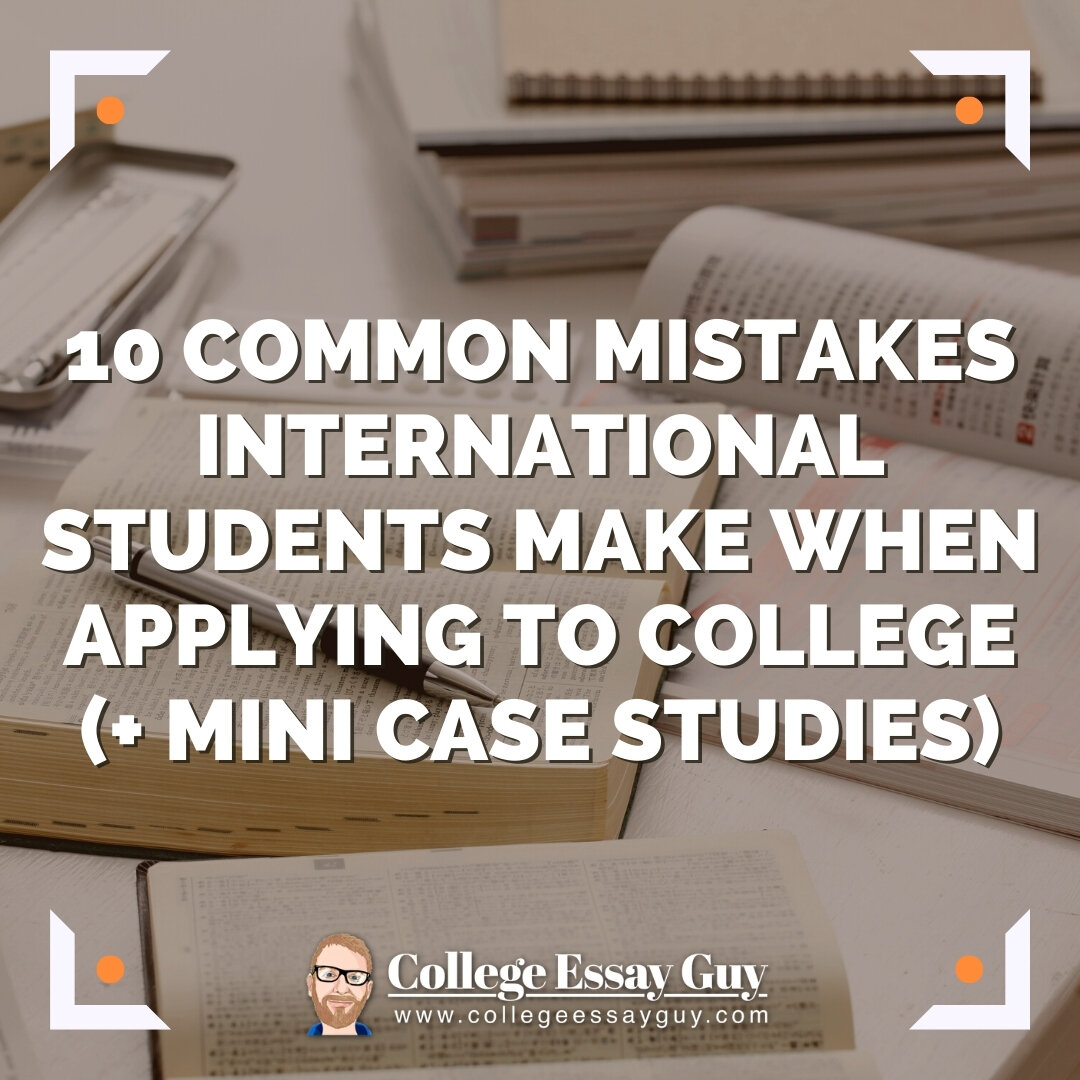This post was written especially for College Essay Guy by
Kristen Karovic, IEC and Founder of College Bloom
Alexandra Feinson, Deputy Director of University Counseling at UWC Changshu China
—Disclaimer: For the purposes of this article, an “international student” is a student who is a “nonresident alien”—not a U.S. citizen, U.S. national or eligible non-resident, who has not passed the green card test or the substantial presence test—, regardless of where the student completed his/her high school education. “College” and “university” are also used interchangeably.
— — —
So you’re thinking about college applications. You’re scrolling through college websites, making lists of pros and cons about different schools, researching enrollment requirements and tuition costs. Perhaps you’re starting to imagine yourself on a college campus—imagining what you’ll be studying and what your roommate will be like.
It’s an exciting time—but overwhelming as well. Let’s face it: applying to college is hard! Too often, we see students make the same mistakes year after year.
So, we’ve compiled this list: the 10 most common mistakes international students make during the planning and application processes, and our advice to make sure you don’t repeat them.
1. Applying to universities/countries you can’t afford
Sandy had always dreamed of attending college in a big city. Growing up in a small town, they knew higher education was their chance to experience the excitement of urban life: restaurants, museums, public transit! So Sandy filled their college list accordingly: UCLA, King’s College London, University of Amsterdam, National University of Singapore, University of Sydney…the bigger the city, the better. Sandy’s family could afford to pay about USD 10,000 a year for their higher education, but Sandy was confident they would be able to find a way to pay.
When it came time to receive decisions, Sandy was receiving some acceptances from schools on their list (schools that don’t factor in the family’s ability to afford the total cost of the education). But…they weren’t getting scholarship offers to reduce the total price, thereby matching their budget.
Sandy hadn’t realized that many of the schools on their list didn’t offer financial aid, and expected students to find their own means to afford their education. So Sandy began scrambling to research external scholarships and found that many deadlines had passed in the locations they had been considering.
Our advice: No matter how strong your applications are, it is not safe to plan on being “the one” student who is going to receive the full financial support you need to make your higher education financially possible. Research the actual costs of college before making your list: it is very important to have universities, both at home and abroad, that fit your total budget. You can also learn about what funding opportunities are available from the university, but also keep in mind how competitive it is to get those funds.
2. Only focusing on the most selective U.S. universities that offer full financial support
Edgardo had an idea that his chances of being accepted at a U.S. school with a “full ride,” as much financial support as possible to cover all expenses of his higher education was a reach, but it was only when he went through the entire application season that he had learned the hard way. Cornell, Williams, Middlebury, and others, had all denied him an acceptance.
Our advice: This situation is such a common struggle that we wrote an entire guide dedicated to The Hard Truth About Getting a Full Scholarship in the USA for International Students (Tips + Guide). Take your time to read it carefully and work through the recommendations about how moving forward with your higher education can still be possible.
3. Thinking that working while studying will be able to pay for all your indirect costs
Karla is from Guatemala. As she began the process of applying to colleges, she knew that cost was a limiting factor for her family. When she received some financial aid from Grinnell College in Iowa, she was excited and quickly began making a budget that included both the remaining cost of tuition and indirect costs for her first year. She calculated that if she worked 25 hours outside of classes, she’d be able to cover the remaining tuition costs and her indirect costs. She knew this would be a heavy load, but she was up for the challenge.
What Karla didn’t realize is that, as an international student, there would be limitations on how much and where she could work. Karla would be limited to work-study opportunities and to working a maximum of 12 hours/week. Her student visa wouldn’t allow her to get a job at a local café or restaurant to cover her remaining expenses.
Our advice: If you’re planning to work while in college, be sure to research the work restrictions that come along with your student visa. Many student visas allow students to either only work on-campus or to work up to 20 hours, but it will depend on the country’s regulations. In addition, being a student is a huge time commitment. Even if you’re legally able to work, be realistic about how much you can work while still prioritizing your academics.
4. Not assessing your fit with your chosen major before you apply
Giuseppe said he wanted to study medicine: his family suggested he would be good at it, and there was a university in his country that would support him. He passed the national exam and...he was in!
But time passed. The coursework was rigorous, and semester after semester started to drag on for Giuseppe. He wasn’t resonating with what he was studying, and working through his coursework became a chore. Had he wasted some time and energy? What should he do?
Our advice: Research the coursework, number of years for the degree, and job and graduate school placements. Speak with students in the program/degree you are interested in before you apply or commit to a university. Ask about mentorship and support that the university can provide for you. Ask people who you know well about areas that they think you would be successful in: ask them where they see you in five years, and in 10 years. Research the flexibility you have to change programs or majors. Take career, personality, and/or interest inventory assessments before you apply to college and evaluate the results carefully.
5. Applying to too many universities
Ivan is from Ukraine and was on a gap year when he maxed out his Common Application with 20 schools. Although he’s busy with his start up and has responsibilities at home with family and their small business, it took him three straight months to fill out his applications. In addition, he was applying to universities that were not on the Common Application, each with their own deadlines and applications. He was really stressed.
Although it wasn’t intentional, it was truly hard for him to thoroughly research and interact with each school, resulting in varied quality across his applications.
He also didn’t realize that the financial paperwork involved for each of his 20 schools would be so time-consuming, or that when he wanted to update his colleges with new information about his Duolingo score and then again regarding how his internship was cancelled after he had applied, each update would require more than 20 separate emails. His essays were recycled (which can be an awesome technique), but his ultimate message to each school varied in terms of quality, especially as deadlines approached.
Our advice: Be intentional with your school list. Ask yourself how much time you really have to dedicate not only to the research needed, but also to the applications themselves. Start with a balanced U.S./non-U.S. list of your favorite safeties, fits, and reaches (including affordable options). Make a plan to perhaps later add more schools based on the time you have to invest in each.
6. Not prioritizing international student support in a university in conjunction with academic and financial fit
Sofia was dreaming of attending college far from home: the university she chose had a strong culinary arts program—her program of interest—and was in a location that was accessible for her to fly back home rather easily. Her parents said they could afford it and only wanted to see her happy. Sofia felt happy with her choice.
However, when Sofia arrived, there was not an Orientation Day or Week to get her settled in her new home, and no “Buddy System'' with student ambassadors to meet new students. In addition, she was placed in a residence that was far from her classes, so it made it difficult to share meal times with other freshmen. It seemed that her classmates were all friends already, since most came from the surrounding area, and she found it hard to integrate. She hadn’t looked up where students were from, if anyone spoke one of her native languages, and didn’t think to ask about campus services, such as a counseling center. She felt very homesick.
Our advice: Before you apply, ask to speak to current students on campus by connecting with the Admission Office to find someone who matches your background and interests. Look through student blogs and takeovers on social media to learn what students are like. Research what services the university of your dreams has to offer and evaluate what’s important to you. Will it help you to be picked up from the airport? Will the housing offered (or not offered) help you meet other students easily? Where do students spend holidays: will they fly home or will there be other students on campus?
Ultimately, who can you speak to both before and after you arrive to help support you?
7. Not applying to universities in your home country/closest city
João wants to study outside of Brazil after high school. He has a tuition-free public university within a commutable distance, but he sets his focus on applying to only universities abroad. What opportunities might he be missing out on?
Our advice: Value the higher education possibilities that surround you. Ask yourself why you want to study in another country in the first place: what are your five year goals? Where do you see yourself in 10 years? Do you have to study outside of your home country? What if your Plan A falls apart? Consider alternative routes that could bring you to your ultimate goal.
Instead of relying on hearsay, inform yourself of your local higher education options, any applicable entrance exams, deadlines for application, and total cost.
8. Recalculating your high school grade point average (GPA)
Arturo is graduating with a high school diploma from Panama, which uses the 5.0 scale to report final grades to students. However, as he looks at U.S. university first year profiles and information about scholarships, he notices a term over and over again: “grade point average,” a number listed out of 4.0. The good math student that he is, Arturo decides to use cross multiplication to convert his 4.4 out of 5.0 grade point average to the 4.0 scale, giving him a 3.52 out of 4.0.
Our advice: DO NOT RECALCULATE YOUR HIGH SCHOOL GRADES! A university representative will always read your entire application, including your transcript with whatever grading scale is provided, in context and with their own internal matrices. If you aren’t certain if your grades in high school make you a great candidate for a university, specific program, or scholarship, reach out to the admission office directly and ask for clarification. They appreciate hearing from you and it’s a good way to begin building a connection.
9. Making mistakes on your financial aid application
Zhang was feeling really good about his applications. They were excellent and finished way ahead of time. He’d already submitted his CSS profile or International Student Financial Aid Application (ISFAA) to every U.S. school on his list. Most of the financial terms were new to him, but he used Google translate when looking at finances with his parents. When April decisions came around, he was thrilled he had gotten into an institution that was going to meet 100% of his demonstrated need! When he looked at the financial aid package, though, he realized it was much lower than what he really needed. He thought he may have made a mistake on his financial aid forms and wrote a financial appeal letter to his university, using this guide. He also listened to Joan Liu’s podcast and realized he should have listed the universities he was applying to on his financial aid application in alphabetical order, that way avoiding any possibility of indicating his preferences to his universities.
Our advice: Read this step-by-step financial aid guide and, if you can, try to get someone with expertise to carefully read your financial aid documents. If you don’t have someone who can help, reach out to your local EducationUSA office.
10. Failing to complete additional requirements after submission
Cho was feeling positive about her applications! She had followed the guidance for the non-US timeline and submitted all of her materials by each respective deadline. Now that the hard work of applying was over, Cho turned her attention back to her homework, school activities, and getting a little break from all this college “stuff.” Unfortunately, by putting college in the back of her mind during the waiting-to-hear-back period, Cho was missing emails from schools indicating that she was missing documents. She didn’t check all of her portals after applying either.
The result? One U.S. school never received her Certificate of Finance form, while another in Canada reached out to her regarding an English language proficiency test. There was also a university in Singapore where Cho’s counselor had already sent her academic transcript, yet they seemed to be missing some grade information. When it came time to receive her decisions, Cho was surprised to see that her applications had been withdrawn or marked as incomplete for three of her universities.
Our advice: Once you’ve submitted your applications you still have a job to do—check your email! Colleges and universities will alert you to missing documents via email or in your application portal on their website. Make sure you regularly check your “spam” or “junk” email too.
What’s next? Keep reading, friends, so that you stay informed. We want you to have successful planning and application experiences.
Action Items:
Start identifying your priorities and developing a school list. Take a look at How to Develop a Great College List When Applying to Schools Outside the U.S. and How to Research Colleges Outside of the U.S. for lots of helpful guidance.
If cost is a determining factor for you, talk with your family and be realistic about what’s feasible for you. Take a look at:
As you start applying to schools and for financial aid, carefully follow application instructions and make sure you have all documents you need (and any translations!). Check out Non-U.S. College Application & Admissions Timeline and, if you’ll be applying for financial aid in the US, A Step-by-Step Financial Aid Guide for International Students.
Additional CEG Resources for International Students











